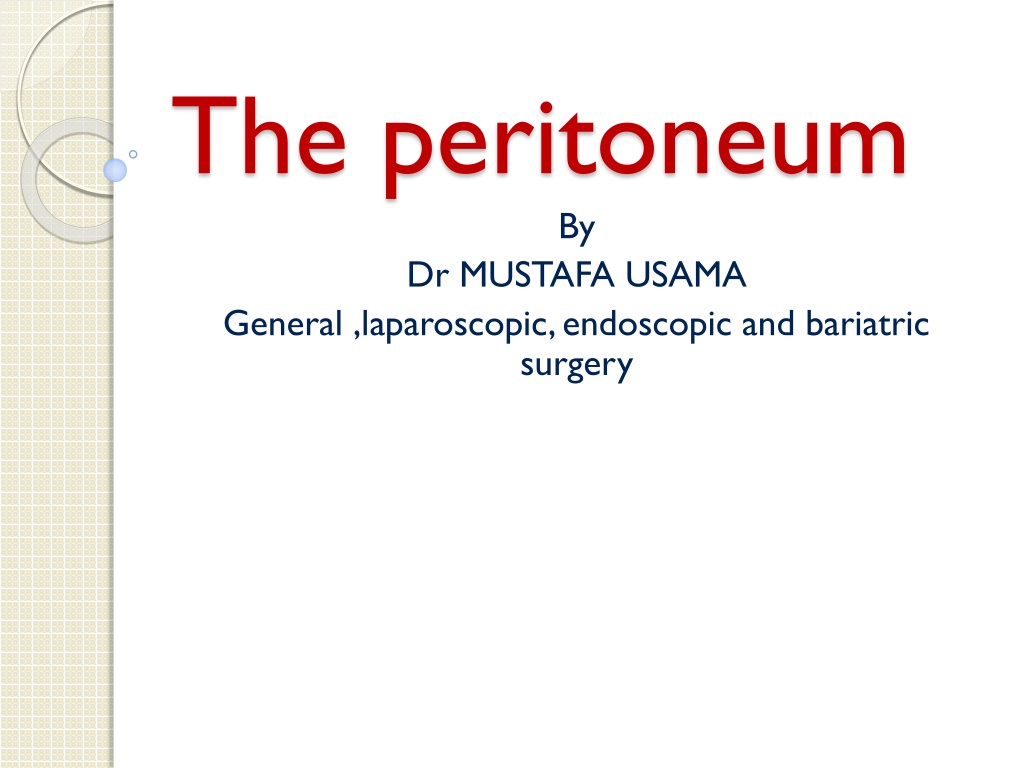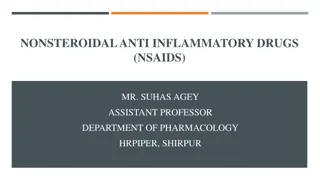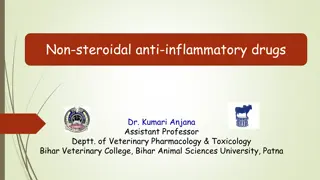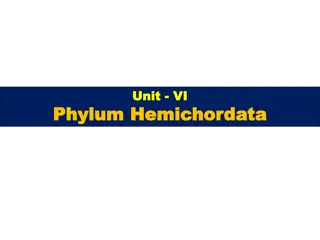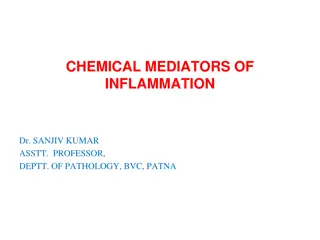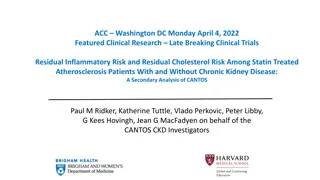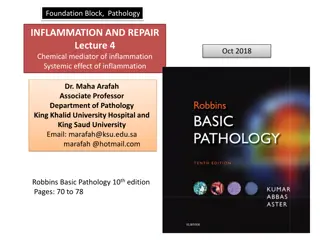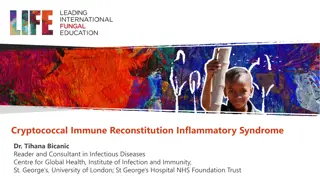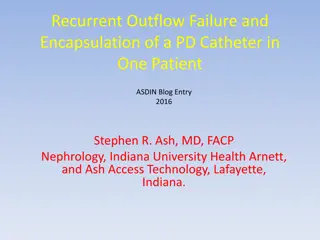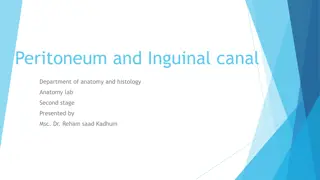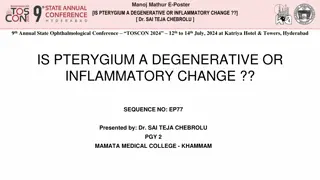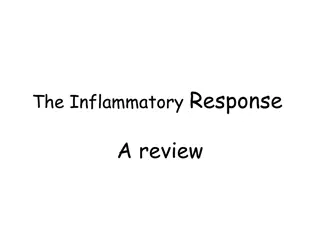Understanding the Peritoneum: Structure, Functions, and Inflammatory Responses
The peritoneum, a vital membrane in the body's abdominal cavity, consists of visceral and parietal components with distinct pain perceptions. It plays crucial roles in lubrication, fluid absorption, immune responses, and more. Peritoneal inflammatory exudate can result from various causes such as bacterial infections, chemical injuries, and trauma. Acute peritonitis, often bacterial in nature, presents a serious medical concern. Knowledge of the peritoneum's anatomy and functions is essential in understanding its role in abdominal health.
Download Presentation

Please find below an Image/Link to download the presentation.
The content on the website is provided AS IS for your information and personal use only. It may not be sold, licensed, or shared on other websites without obtaining consent from the author. Download presentation by click this link. If you encounter any issues during the download, it is possible that the publisher has removed the file from their server.
E N D
Presentation Transcript
The peritoneum By Dr MUSTAFA USAMA General ,laparoscopic, endoscopic and bariatric surgery
Anatomy of peritoneum The peritoneal membrane is divided into two parts\ the visceral peritoneum and the parietal peritoneum. The parietal portion is richly supplied with nerves and, when irritated, causes severe pain accurately localized to the affected area. The visceral peritoneum, in contrast, is poorly supplied with nerves and its irritation causes vague pain that is usually located to the midline.
The peritoneal cavity is the largest cavity in the body, the surface area of its lining membrane (2 m2 in an adult) being nearly equal to that of the skin. The peritoneal membrane is composed of flattened polyhedral cells (mesothelium), one layer thick, resting upon a thin layer of fibroelastic tissue.
only a few milliliters of peritoneal fluid is found in the peritoneal cavity. The fluid is pale yellow, somewhat viscid and contains lymphocytes and other leucocytes.
Functions of the peritoneum Pain perception (parietal peritoneum) Visceral lubrication Fluid and particulate absorption Inflammatory and immune responses Fibrinolytic activity
Causes of a peritoneal inflammatory exudate Bacterial infection, e.g. appendicitis, tuberculosis Chemical injury, e.g. bile peritonitis Ischaemic injury, e.g. strangulated bowel, vascular occlusion Direct trauma, e.g. operation Allergic reaction, e.g. starch peritonitis
ACUTE PERITONITIS Most cases of peritonitis are caused by an invasion of the peritoneal cavity by bacteria. Bacterial peritonitis is usually polymicrobial, both aerobic and anaerobic organisms being present. The exception is primary peritonitis ( spontaneous peritonitis), in which a pure infection with streptococcal, pneumococcal or Haemophilus bacteria occurs.
Bacteria in peritonitis Gastrointestinal source Escherichia coli Streptococci (aerobic and anaerobic) Bacteroides Clostridium Klebsiella pneumoniae Staphylococcus Other sources{e.g. Pelvic infection via the fallopian tubes;} Chlamydia Gonococcus b-Haemolytic streptococci Pneumococcus Mycobacterium tuberculosis
Paths to peritoneal infection Gastrointestinal perforation, e.g. perforated ulcer, diverticular perforation Exogenous contamination, e.g. drains, open surgery, trauma Transmural bacterial translocation (no perforation), e.g. inflammatory bowel disease, appendicitis, ischaemic bowel. Female genital tract infection, e.g. pelvic inflammatory disease Haematogenous spread (rare), e.g. septicaemia
factors may favour the localisation of peritonitis. Anatomical:The greater sac of the peritoneum is divided into (1) the subphrenic spaces, (2) the pelvis and (3) the peritoneal cavity proper. The last is divided into a supracolic and an infracolic compartment by the transverse colon and transverse mesocolon, which deters the spread of infection from one to the other.
Pathological: Flakes of fibrin appear and cause loops of intestine to become adherent to one another and to the parietes. Peristalsis is retarded in affected bowel and this helps to prevent distribution of the infection.The greater omentum, by enveloping and becoming adherent to inflamed structures, often forms a substantial barrier to the spread of infection.
Surgical: Drains are frequently placed during operation to assist localisation (and exit) of intra-abdominal collections: their value is disputed. They may act as conduits for exogenous infection
A number of factors may favour the development of diffuse peritonitis: Speed of peritoneal contamination is a prime factor Stimulation of peristalsis by the ingestion of food or even water hinders localisation The virulence of the infecting organism Young children have a small omentum, which is less effective in localising infection.
Disruption of localised collections may occur with injudicious handling, e.g. appendix mass or pericolic abscess. Deficient natural resistance ( immune deficiency ) may resultfrom use of drugs (e.g. steroids), disease [e.g. acquired immunedeficiency syndrome (AIDS)] or old age.
Clinical features Localised peritonitis: the initial symptoms and signs are those of that condition. When the peritoneum becomes inflamed, the temperature,and especially the pulse rate, rise. Abdominal pain increases and usually there is associated vomiting. The most important sign is guarding and rigidity of the abdominal wall ove the area of the abdomen that is involved, with a positive release sign (rebound tenderness).
If inflammation arises under the diaphragm, shoulder tip ( phrenic ) pain may be felt. In cases ofpelvic peritonitis arising from an inflamed appendix in the pelvic position or from salpingitis,
the abdominal signs are often slight;there may be deep tenderness of one or both lower quadrants alone, but a rectal or vaginal examination reveals marked tendernessof the pelvic peritoneum. With appropriate treatment,localised peritonitis usually resolves; in about 20% of cases, anabscess follows..
Infrequently, localized peritonitis becomes diffuse. Conversely, in favorable circumstances, diffuse peritonitis can become localized, most frequently in the pelvis or at multiple sites within the abdominal cavity
Diffuse (generalised) peritonitis: EarlyAbdominal pain is severe and made worse by moving or breathing.It is first experienced at the site of the original lesion and spreads outwards from this point. Vomiting may occur. The patient usually lies still. Tenderness and rigidity on palpation are found typically when the peritonitis affects the anterior abdominal wall.
Abdominal tenderness and rigidity are diminished or absent if the anterior wall is unaffected, as in pelvic peritonitis or,rarely, peritonitis in the lesser sac
Late If resolution or localisation of generalised peritonitis does not occur, the abdomen remains silent and increasingly distends Circulatory failure ensues, with cold, clammy extremities, sunken eyes, dry tongue, thready pulse and drawn and anxious face (Hippocratic facies}
The Hippocratic facies in terminal diffuse peritonitis
Clinical features in peritonitis Abdominal pain, worse on movement Guarding/rigidity of abdominal wall Pain/tenderness on rectal/vaginal examination (pelvic peritonitis) Pyrexia (may be absent) Raised pulse rate Absent or reduced bowel sounds Septic shock [systemic inflammatory response syndrome (SIRS)] in later stages
Investigations A radiograph of the abdomen may confirm the presence of dilated gas-filled loops of bowel (consistent with a paralytic ileus) or show free gas, although the latter is best shown on an erect chest radiograph
Gas under the diaphragm in a patient with free perforation and peritonitis
Serum amylase estimation may establish the diagnosis of acute pancreatitis. Ultrasound and computerised tomography (CT) scanning. Peritoneal diagnostic aspiration may be helpful but is usually unnecessary. Bile-stained fluid indicates a perforated peptic ulcer or gall bladder; the presence of pus indicates bacterial peritonitis. Blood is aspirated in a high proportion of patients with intraperitoneal bleeding
Acute pancreatitis seen on computerised tomography scanning with swelling of the gland and surrounding inflammatory changes
Investigations in peritonitis Raised white cell count and C-reactive protein are usual Serum amylase > 4 normal indicates acute pancreatitis Abdominal radiographs are occasionally helpful Erect chest radiographs may show free peritoneal gas (perforated viscus) Ultrasound/CT scanning often diagnostic Peritoneal fluid aspiration (with or without ultrasound guidance) may be helpful
Treatment General care of the patient Correction of fluid and electrolyte imbalance Insertion of nasogastric drainage tube Broad-spectrum antibiotic therapy Analgesia Vital system support Operative treatment of cause when appropriate with peritoneal debridement/lavage
Specific treatment of the cause If the cause of peritonitis is amenable to surgery, operation must be carried out as soon as the patient is fit for anaesthesia.This is usually within a few hours. In peritonitis caused by pancreatitis or salpingitis, or in cases of primary peritonitis of streptococcal or pneumococcal origin, non-operative treatment is preferred provided the diagnosis can be made with confidence
Peritoneal lavage cause has been dealt with, the whole peritoneal cavity is explored with the sucker and, if necessary, mopped dry until all seropurulent exudate is removed. The use of a large volume ofsaline (1 2 litres) containing dissolved antibiotic (e.g. tetracycline)has been shown to be effective
Systemic complications of peritonitis Bacteraemic/endotoxic shock Bronchopneumonia/respiratory failure Renal failure Bone marrow suppression Multisystem failure
Abdominal complications of peritonitis Adhesional small bowel obstruction Paralytic ileus Residual or recurrent abscess Portal pyaemia/liver abscess
Primary peritonitis Primary pneumococcal peritonitis may complicate nephrotic syndrome or cirrhosis in children. At other times, and always in males, the infection is blood-borne and secondary to respiratory tract or middle ear disease. The onset is sudden and the earliest symptom is pain localised to the lower half of the abdomen. The temperature is raised to 39 C or more and there is usually frequent vomiting
After 2448 hours, profuse diarrhoea is characteristic. There is usually increased frequency of micturition.
